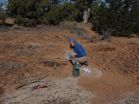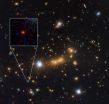(Press-News.org) Magnetotactic bacteria, like Magnetospirillum magneticum, have evolved cellular processes that allow them to take up iron molecules to produce magnetic nanocrystals like magnetite. Since they were first discovered and isolated in 1975 by Robert Blakemore, scientists continue to be fascinated by these unique bacteria, whether as a means to isolate biogenic magnetite or to understand the evolutionary advantages of producing these minerals. A new video-article in JoVE (Journal of Visualized Experiments) details a procedure to purify and enrich samples of magnetotactic bacteria from aquatic environments, developed in the laboratory of Dr. Brian Lower at The Ohio State University.
Magnetotactic bacteria are microorganisms, typically found in stratified water columns or aquatic sediments all over the world. Though many of these bacteria tend to thrive in environments with low levels of oxygen, the defining characteristic they share are small, magnetic, membrane bound nanocrystals of either the iron oxide magnetite or the iron sulfide greigite.
"These nanocrystals allow the organisms to align themselves with the earth's magnetic field and swim up or down based on the geomagnetic field to find their microenvironments," Dr. Lower explains. "These bacteria are fairly ubiquitous. They can be found all over the world, and interestingly they can be found in sediment samples from millions of years ago."
These bacteria are a valuable anomaly to the scientific community. Their fossil record gives geologists accurate representations of the Earth's past magnetic field, when combined with carbon dating, and could potentially provide other clues about earth's geological history. The magnetotactic minerals may also have medical or other novel applications. "You can coat these minerals with antibodies and target specific cancer cell lines or heat the magnets with an alternating magnetic field to kill a cancer cell line," says Dr. Lower.
"We decided to publish in JoVE because it will allow a wide variety of scientists to see how easy it is to isolate and enrich these species. We hope the video-protocol will spur other collaborations or new research," Dr. Lower said. The article will be published on November 15, 2012 in JoVE's General section. JoVE acquisition editor Rachelle Baker stated, "We are very excited for this article not only because it is our first featuring magnetotactic bacteria but we believe it will lay a foundation for other groups to build expand upon this work and share their methods with the community, which is the founding principle of JoVE."
INFORMATION:
Lower et. al. http://www.JoVE.com/video/50123/collection-isolation-enrichment-naturally-occurring-magnetotactic
About JoVE, The Journal of Visualized Experiments:
JoVE, the Journal of Visualized Experiments, is the first and only PubMed/MEDLINE-indexed, peer-reviewed journal devoted to publishing scientific research in a video format. Using an international network of videographers, JoVE films and edits videos of researchers performing new experimental techniques at top universities, allowing students and scientists to learn them much more quickly. As of November 2012, JoVE has published video-protocols from an international community of nearly 6,000 authors in the fields of biology, medicine, chemistry, and physics.
URL: www.JoVE.com
To link to this release, please use this link: http://www.JoVE.com/about/press-releases/49/video-article-shows-how-to-purify-magnetic-bacteria
Contact:
Neal Moawed
Academic Liaison & Marketing Associate
The Journal of Visualized Experiments
p. 617.945.9051
e. neal.moawed@JoVE.com
Video-article shows how to purify magnetic bacteria
2012-11-16
ELSE PRESS RELEASES FROM THIS DATE:
Researchers report potential new treatment to stop Alzheimer's disease
2012-11-16
Last March, researchers at UCLA reported the development of a molecular compound called CLR01 that prevented toxic proteins associated with Parkinson's disease from binding together and killing the brain's neurons.
Building on those findings, they have now turned their attention to Alzheimer's disease, which is thought to be caused by a similar toxic aggregation or clumping, but with different proteins, especially amyloid-beta and tau.
And what they've found is encouraging. Using the same compound, which they've dubbed a "molecular tweezer," in a living mouse model ...
WSU scientists find new way for antibiotic resistance to spread
2012-11-16
PULLMAN, Wash.—Washington State University researchers have found an unlikely recipe for antibiotic resistant bacteria: Mix cow dung and soil, and add urine infused with metabolized antibiotic. The urine will kill off normal E. coli in the dung-soil mixture. But antibiotic-resistant E. coli will survive in the soil to recolonize in a cow's gut through pasture, forage or bedding.
"I was surprised at how well this works, but it was not a surprise that it could be happening," says Doug Call, a molecular epidemiologist in WSU's Paul G. Allen School for Global Animal Health. ...
Young gamers offer insight to teaching new physicians robotic surgery
2012-11-16
What can high school and college-age video game enthusiasts teach young surgeons-in-training?
According to a new study from researchers at the University of Texas Medical Branch at Galveston (UTMB) – a world leader in minimally invasive and robotic surgery – the superior hand-eye coordination and hand skills gained from hours of repetitive joystick maneuvers mimic the abilities needed to perform today's most technologically-advanced robotic surgeries.
To offer insight on how best to train future surgeons, the study placed high school and college students head to head ...
Degraded military lands to get ecological boost from CU-led effort
2012-11-16
Some arid lands in the American West degraded by military exercises that date back to General George Patton's Word War II maneuvers in the Mojave Desert should get a boost from an innovative research project led by the University of Colorado Boulder.
Headed up by CU-Boulder Assistant Professor Nichole Barger, the research team is focused on developing methods to restore biological soil crusts -- microbial communities primarily concentrated on soil surfaces critical to decreasing erosion and increasing water retention and soil fertility. Such biological soil crusts, known ...
Hubble helps find candidate for most distant object in the universe yet observed
2012-11-16
By combining the power of the NASA/ESA Hubble Space Telescope, NASA's Spitzer Space Telescope and one of nature's zoom lenses, astronomers have found what is probably the most distant galaxy yet seen in the Universe. The object offers a peek back into a time when the Universe was only 3 percent of its present age of 13.7 billion years.
We see the newly discovered galaxy, named MACS0647-JD, as it was 420 million years after the Big Bang. Its light has travelled for 13.3 billion years to reach Earth, which corresponds to a redshift of approximately 11 [1].
This is the ...
Quick, high-volume test offers fast track in search for Alzheimer's drugs
2012-11-16
An efficient, high-volume technique for testing potential drug treatments for Alzheimer's disease uncovered an organic compound that restored motor function and longevity to fruit flies with the disease, according to new research that could help put the search for an effective Alzheimer's drug on a faster track.
Princeton University researchers report in the Journal of Biological Chemistry that they discovered an organic compound that prevented the formation of protein clumps, or aggregates, found on human brain cells afflicted by Alzheimer's disease. The researchers ...
Neurons made from stem cells drive brain activity after transplantation in laboratory model
2012-11-16
LA JOLLA, Calif., November 15, 2012 – Researchers and patients look forward to the day when stem cells might be used to replace dying brain cells in Alzheimer's disease and other neurodegenerative conditions. Scientists are currently able to make neurons and other brain cells from stem cells, but getting these neurons to properly function when transplanted to the host has proven to be more difficult. Now, researchers at Sanford-Burnham Medical Research Institute (Sanford-Burnham) have found a way to stimulate stem cell-derived neurons to direct cognitive function after ...
Barrow scientists discover ways to optimize light sources for vision
2012-11-16
(Phoenix, AZ Nov. 15, 2012) -- Vision researchers at Barrow Neurological Institute have made a groundbreaking discovery into the optimization of light sources to human vision. By tuning lighting devices to work more efficiently with the human brain the researchers believe billions of dollars in energy costs could be saved.
The research was conducted by Stephen Macknik, PhD, of Barrow's Laboratory of Behavioral Neurophysiology, and Susana Martinez-Conde, PhD, of Barrow's Laboratory of Visual Neuroscience. The study is published Proceedings of the National Academy ...
Researchers outline effective strategies to prevent teen depression and suicide
2012-11-16
Untreated depression is one of the leading causes of teen suicide, and signs of depression can also be a warning that a teen is contemplating suicide. In an article published this week in the quarterly journal, The Prevention Researcher, University of Cincinnati researchers are describing how positive connections can help offset these tragedies.
In the current issue, titled, "Teen Depression," UC researchers Keith King, a professor of health promotion, and Rebecca Vidourek, an assistant professor of health promotion, report that depression and suicide are "intricately ...
New injectable gels toughen up after entering the body
2012-11-16
CAMBRIDGE, MA -- Gels that can be injected into the body, carrying drugs or cells that regenerate damaged tissue, hold promise for treating many types of disease, including cancer. However, these injectable gels don't always maintain their solid structure once inside the body.
MIT chemical engineers have now designed an injectable gel that responds to the body's high temperature by forming a reinforcing network that makes the gel much more durable, allowing it to function over a longer period of time.
The research team, led by Bradley Olsen, an assistant professor of ...




